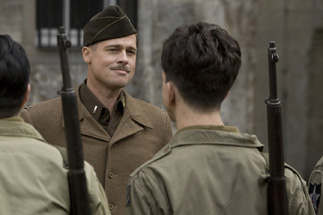Movie Review: Inglourious Basterds
By Matthew Huntley
August 31, 2009
If Bryan Singer's Valkyrie depicts the true story of an assassination attempt on Adolf Hitler, then Quentin Tarantino's Inglourious Basterds [sic] is its fictional and irreverent twin brother. Both films suggest an alternate history and a different way the Nazi regime might have fallen, but Tarantino is allowed more creative freedom since his story isn't limited by fact and he's able to give his heroes a successful ending. Basterds is also a lot more colorful and extreme, which is one of its lasting charms, among other things.
I've thought a lot about this film since I saw it and can't think of a reason Tarantino made it other than to induce us with shock, drama and, most of all, entertainment. He's not looking to provide us a history lesson. Rather, he utilizes history while simultaneously toying with it. The result is something quite pleasing and unique.
On the one hand, this is a darkly comical story about a group of American soldiers with one clear-cut objective: "killin' Nahtzis." On the other, it's a tragic tale of survival and revenge, with strong performances and intense violence. Somehow, both are able to exist on the same plane.
For obvious reasons, the studio is selling Basterds as a Brad Pitt vehicle, although it may surprise you how little Pitt is actually in the film. When he's on screen, he's a treat to watch, playing the determined Lt. Aldo Raine, a patriotic American from Tennessee heading a gang of Jewish soldiers who proclaim themselves the Inglourious Basterds. They live only for thing: to kill Nazis in the most gruesome ways. Raine orders his men to give him one hundred Nazi scalps apiece, and if you think Tarantino won't show them delivering the goods, think again.
Pitt, with his stuck out jaw and raspy Southern accent, is certainly good in the film, but he doesn't make or break it. The best performance comes from Christoph Waltz as the suave and formal Hans Landa, a Nazi Colonel nicknamed the "Jew Hunter." The film, which takes place in Nazi-occupied France in 1941, opens with Landa paying a visit to a French dairy farmer, who may or may not be hiding Jews in his house. Notice how comfortable Landa presents himself on camera. We should be disgusted by this man and the casualness with which he carries out his Party's wishes and the artificiality of his character, but Landa makes it impossible for you to look away. He mesmerizes us.
Tarantino is clearly fascinated by him too. Watch how the camera acutely observes Waltz's mannerisms, gestures, and facial expressions. When the man drinks milk, Tarantino holds on him until he's finished. Normally this filming style would drive us crazy and we'd be biting our nails until the film got a move on, but the generous pacing of these scenes, along with their unforeseen consequences, helps drive them toward truly effective payoffs.
During the opening massacre, a young Jewish woman (Melanie Laurent) escapes and flees to Paris, where she takes over her family's cinema. Landa sees her run away but lets her live, probably because he thinks she's something worth hunting at a later time.
In Paris, the young woman, named Shosanna, catches the eye of a boyish Nazi soldier (Daniel Brühl), who's become a local celebrity and certified war hero for killing hundreds of enemy soldiers from a crow's nest all by himself. Joseph Goebbels (Sylvester Groth) was so impressed by the boy's statistics, he had a propaganda film made about him, which the Nazis want to premiere at Shosanna's theater. She accepts the offer and thinks it a perfect opportunity to kill all the heads of the Party, including the Fuehrer himself (Martin Wuttke). The British have also learned of the premiere and enlist the Basterds and a German actress (Diane Kruger), working as a double agent, to carry out an assassination.
For a two and a half-hour film, it's ironic how few scenes there actually are in Inglourious Basterds. Each scene just happens to be longer than usual, but not necessarily too long. Sure, there are times when Tarantino tries our patience (once again, he shows he can be too in love with his own dialogue and character observation), but he hits the majority of his marks. The film negotiates with its extended moments by building tension where necessary as a way to keep things moving. Tarantino employs a variety of devices to accomplish this, including cleverly staged crane shots; off-screen dialogue from another character; close-ups of peculiar images, like food; and subtle looks from characters trying to resist exposure.
Inglourious Basterds has a lot of hard suspense, but it also has its fair share of humor and sensationalism, thanks mostly to the anachronistic Basterds gang. They possess a 1970s gangster sensibility and Tarantino moves them to the rhythms of Spaghetti Western music. And it just wouldn't be Tarantino without a couple freeze frames, animated text and graphic novel-like interludes to introduce the more colorful characters. On paper, these more outrageous scenes shouldn't gel with the stern and serious backdrop of World War II, but Tarantino makes them fit. It also works because, frankly, we haven't seen this style done before.
I have a feeling many viewers will not appreciate both sides of this movie — they'll either like the austere drama OR the exploitative, sensational bloodbath, but probably not both. Their guts will tell them Tarantino should have gone one way or the other. But luckily Tarantino is no ordinary director; he takes chances and gambles with his narratives. He directs with his instincts instead of abiding by genre rules. What genre would Inglourious Basterds fall into, anyway? Like all the great Tarantino movies, it's a mix, and each one is taken in a radical direction that makes it hard to categorize. Usually, that's the sign of something special.




